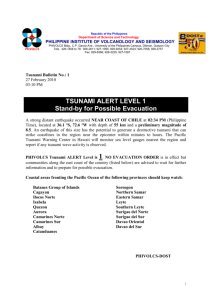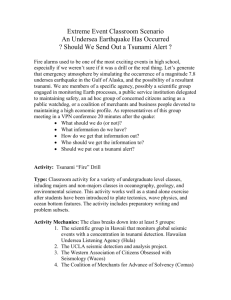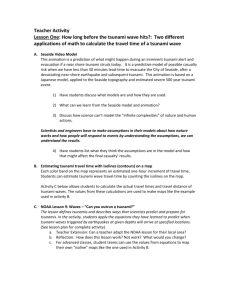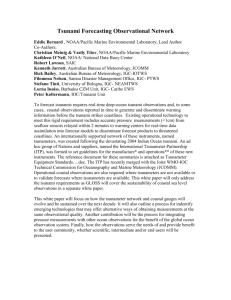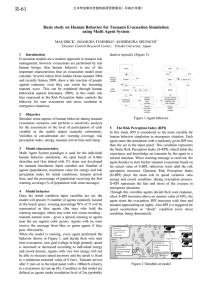Be PREPARED before a Tsunami strikes: Know the tsunami history
advertisement
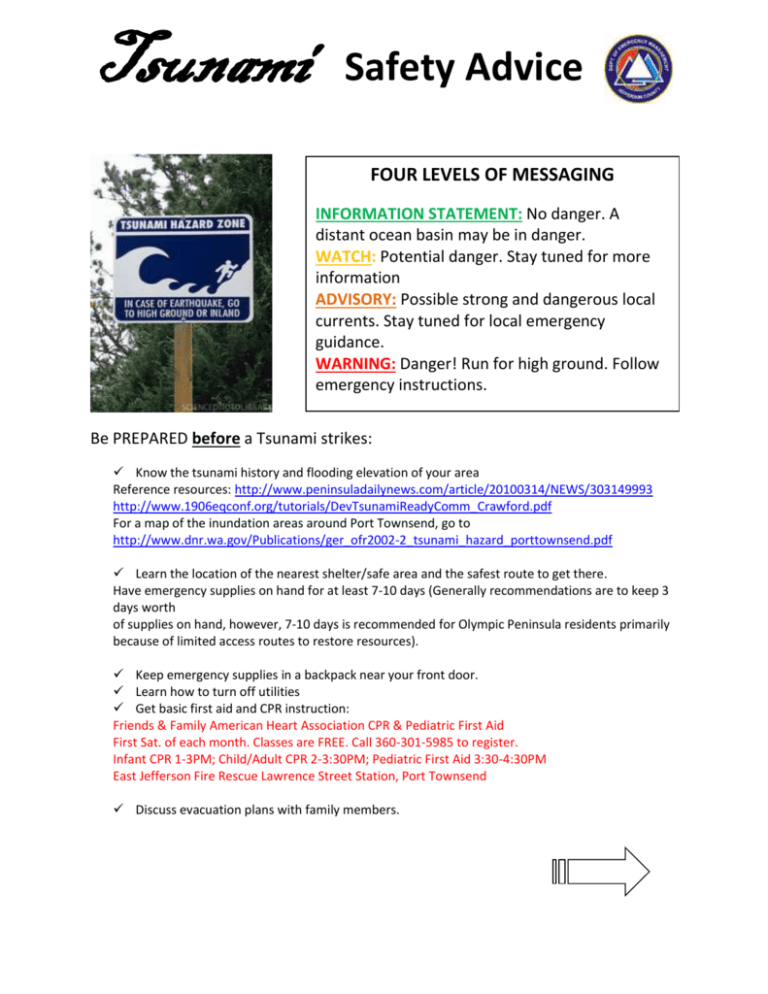
Tsunami Safety Advice FOUR LEVELS OF MESSAGING INFORMATION STATEMENT: No danger. A distant ocean basin may be in danger. WATCH: Potential danger. Stay tuned for more information ADVISORY: Possible strong and dangerous local currents. Stay tuned for local emergency guidance. WARNING: Danger! Run for high ground. Follow emergency instructions. Be PREPARED before a Tsunami strikes: Know the tsunami history and flooding elevation of your area Reference resources: http://www.peninsuladailynews.com/article/20100314/NEWS/303149993 http://www.1906eqconf.org/tutorials/DevTsunamiReadyComm_Crawford.pdf For a map of the inundation areas around Port Townsend, go to http://www.dnr.wa.gov/Publications/ger_ofr2002-2_tsunami_hazard_porttownsend.pdf Learn the location of the nearest shelter/safe area and the safest route to get there. Have emergency supplies on hand for at least 7-10 days (Generally recommendations are to keep 3 days worth of supplies on hand, however, 7-10 days is recommended for Olympic Peninsula residents primarily because of limited access routes to restore resources). Keep emergency supplies in a backpack near your front door. Learn how to turn off utilities Get basic first aid and CPR instruction: Friends & Family American Heart Association CPR & Pediatric First Aid First Sat. of each month. Classes are FREE. Call 360-301-5985 to register. Infant CPR 1-3PM; Child/Adult CPR 2-3:30PM; Pediatric First Aid 3:30-4:30PM East Jefferson Fire Rescue Lawrence Street Station, Port Townsend Discuss evacuation plans with family members. When a TSUNAMI WATCH is issued for your area: A WATCH means a dangerous tsunami has not yet been verified. If one exists, it may only be one hour away. Frequently monitor radio, Coast Guard emergency frequencies, NOAA Weather Radio or other reliable source. If you live in a low lying area, check your emergency supplies. Remember to include special medications, infant needs, warm clothing, water and cash. Review evacuation plans with family members. If you have special evacuation needs (handicapped, elderly, small children), consider early evacuation. If time permits, secure important loose objects around your home/business. Only consider taking your boat to deep water if time, weather and its seaworthiness permit. Be prepared to evacuate. When a TSUNAMI WARNING is issued in your area: A Tsunami Warning means a dangerous tsunami may have been generated and could be very close. Estimated times of wave arrival are given for selected coastal areas. If you are on the beach or near the shoreline, and you feel an earthquake evacuate to higher ground immediately. DO NOT WAIT FOR A FORMAL WARNING. Closely monitor radio, Coast Guard emergency frequencies, NOAA Weather Radio or other reliable source. (For Jefferson County, the Puget Sound Marine frequency is 162.425. Frequencies for other parts of Washington State can be found at www.weather.gov/nwr/Cnty/Cov/nwrWA.htm) Follow instructions issued by local officials. Leave immediately if ordered to do so. Take your emergency kit with you. NEVER go down to the beach to watch the tsunami. Turn off your electric and propane services at the main IF time permits. Do not use the telephone except in a genuine emergency. Once in a safe place, do not return to the hazard zone until local officials have issued an “all clear.” All tsunamis, like hurricanes, are potentially dangerous even though they may not damage every coastline they strike.





